22 Apr 24
Lab ChatLabworx
The Global News Source for the World of Science and Chemicals
UAE opens first ARAB NUCLEAR POWER PLANT
31 August 2020
Chem Chat
The UAE has become the first Arab country to open a nuclear power plant this month with the unveiling of its 5,600GW Barakah facility near Ruwais. The project is the latest attempt by the Emirati government to diversify its energy and their economic portfolios and transform its oil companies into broader energy firms, thus reducing the country’s over-reliance on fossil fuels and transitioning to clean forms of power generation.
The grand opening of the Barakah site is a significant milestone for the Middle East, given that it has a long-established reputation as an oil-rich part of the world. The UAE’s willingness to plough ahead and pioneer the use of nuclear technology could serve as a blueprint for other neighbouring countries who wish to face up to their environmental responsibilities and seek alternative sources of energy.
An Arab first
Although there are other nuclear facilities in the Middle East, the Barakah plant is the first to be opened in an Arab nation. Once operational, Barakah will be able to provide one quarter of the UAE’s power needs, helping the government in its push to move away from an over-reliance on fossil fuels for both its energy portfolio and its financial stability.
The government had weighed up alternative options, including natural gas and renewables such as wind and solar, but opted for nuclear due to the vast quantities of energy it can produce.
The plant has been in the works for some time. The UAE signed a cooperation agreement with the USA in 2009 that grants it access to both raw materials and technical assistance associated with the manufacture of a nuclear power plant. Putting that knowledge to good use, the Barakah plant has since been given the green light by the International Atomic Energy Agency as being compliant with their strict operational standards.
Setting a new trend
While Barakah might be the first Arab nuclear power plant, it certainly seems as though it will not be the last. Both Saudi Arabia and Egypt have plans in the pipeline to build facilities in the coming years, signalling something of a potential nuclear revolution in the region.
For its part, Egypt has being eyeing up the construction of a nuclear power station for well over 50 years and as far back as 1983, the site of Al Dabaa on the Mediterranean Coast was earmarked as being the ideal location. Plans are now firmly afoot to construct four Russian-built nuclear reactors in the coming years, yielding a total capacity of 4,800 GW upon the plant’s eventual completion.
Meanwhile, Saudi Arabia is also contemplating a transition to nuclear as part of the Crown Prince’s Saudi 2030 Vision, which plans to diminish the nation’s reliance on oil. It is currently in talks with the USA over a nuclear cooperation deal.
DOWNLOAD PDF

2 Day Seminar Program
@ ArabLab+ 2024
24 & 25 September 2024
Your stay in Dubai
Labkit
Product News
Chemkit
Product News
Thinking about exhibiting at ARABLAB 2024? Watch our video to find out more.
Join the world’s leading organisations…
Get in touch and stay in touch…
Join our mailing list and receive the ARABLAB newsletter and event updates.





















